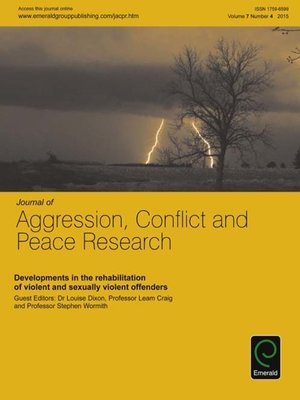Journal of Aggression, Conflict and Peace Research, Volume 7, Number 4
ebook ∣ Developments in the rehabilitation of violent and sexually violent offenders · Journal of Aggression, Conflict and Peace Research
By Robert Cramer

Sign up to save your library
With an OverDrive account, you can save your favorite libraries for at-a-glance information about availability. Find out more about OverDrive accounts.
Find this title in Libby, the library reading app by OverDrive.



Search for a digital library with this title
Title found at these libraries:
| Library Name | Distance |
|---|---|
| Loading... |
The concept of "what works" in offender rehabilitation has received much attention over the past five decades and has evolved to consider detailed questions, such as what works for whom, when offered by whom, in what setting, at what time, with what intensity, and by what means. This e-book aims to advance the theoretical and empirical knowledge base on current developments in the rehabilitation of offenders. It presents five chapters that address some of these questions in sexual offenders in general, adolescent sexual offenders, sexual offenders suffering from mental illness and women offenders. The mode of enquiry adopted in each study is diverse, as are the questions asked: 1) do sexual offender treatment programmes work and do evaluation methodologies affect the research conclusions?; 2) do sexual offender programmes work for juvenile sexual offenders with a specific emphasis on Multi-Systemic Therapy for Problem Sexual Behaviors (MST-PSB) and Cognitive-Behavioural Therapy (CBT); 3) do the supervision plans for sexual offenders on probation align with their criminogenic needs as determined by a standardised risk/needs assessment?; 4) does mental disorder contribute to the offending of mentally disordered sexual offenders and, if so, by what mechanisms might this occur and should their risk assessment, for example on the STATIC-99R, be adjusted accordingly?; 5) how can treatment of female offenders accommodate their characteristic history of victimisation, substance abuse, self-harm and mental health problems and do so in a systematic, effective, and humane manner? Each chapter considers implications for policy and practice for the relevant offender groups investigated and offers wake-up calls to correctional practitioners and the criminal justice agencies they serve.







